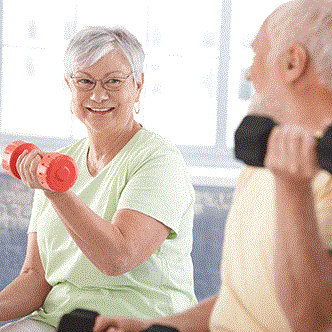
A structured exercise program that is often recommended for people who’ve had a heart attack or have other heart conditions also carries health benefits for people recovering from stroke, according to a small study in the Journal of the American Heart Association.
The pilot study, led by researchers at the University of South Carolina, found that survivors of stroke who completed the three-month, exercise-based cardiac rehabilitation program improved their endurance, strength, overall health, and quality of life. In particular, their ability to go from sitting to standing, as well as how far they were able to walk using a standard 6-minute walk test improved significantly.
It also positively affected their quality of life. Recounting their experience, many participants said the program improved their everyday activity and helped give them a path forward in knowing how to take care of themselves. One said the program was
“life-changing.” At follow-up, most patients (83%) said they were still exercising at least once a week.
While patients may participate in physical therapy immediately after their stroke, the focus tends to be on any loss of function versus building endurance and fitness. Experts warn that being physically inactive after a stroke can make optimal recovery
much more difficult. In fact, about 3 out of 5 people who have survived a stroke don’t get the recommended amount of physical activity, so finding ways to encourage this population is important.
Currently, cardiac rehab is not prescribed or covered for people who’ve had a stroke. But it is standard care after a heart attack to help prevent a second heart attack and build healthy habits. Similarly, people who’ve had a stroke are also
at higher risk for another stroke and heart disease.
“Our most important goal … is to help stroke survivors reduce as many risk factors as possible to prevent future stroke or cardiovascular disease,” said lead study author, Elizabeth W. Regan,
in a statement. She is a Doctor of Physical Therapy (DPT), holds a doctorate in exercise science, and is a clinical assistant professor in the physical therapy program at the University of South Carolina. “Based on these preliminary findings,
we hope prescribing cardiac rehab will be considered for all patients following a stroke, as it is for patients after a heart attack.”
A total of 24 people ranging in age from 33 to 81 and who had a stroke three months to 10 years earlier participated in the study. The researchers sought to investigate whether cardiac rehab could have “similar positive outcomes for patients who
survive a stroke.” Most of the patients had high blood pressure. Heart disease, diabetes, and arthritis also were common. At the start of the program, participants were evaluated for physical strength and function, mental health, and balance.
They participated in 30- to 50-minute exercise sessions three times a week for three months. By the end of the study, all the patients had plans to keep exercising either by continuing a supervised program, joining a gym, participating in group-based
classes, or working with a personal trainer.
“We need to place value on exercise as medicine. Exercise is health, and it is important for every individual, regardless of physical limitations or age. Hopefully, increasing physical activity can be one of the first steps to improving overall
health following a stroke,” Regan said.
The study findings are limited given the small number of patients at a single center. Authors hope this research will pave the way for larger studies to examine the role cardiac rehab can play in stroke recovery.
Visit CardioSmart.org/CardiacRehab to learn
more about cardiac rehabilitation.